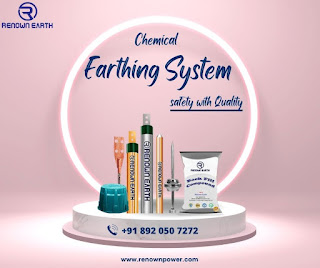What is the distinction between grounding, bonding, and chemical earthing?
Bonding, grounding, and earthing are critical components of electrical systems. In a factory, grounded circuits require an efficient return connection from the technology to the power supply for the device to work effectively.
Non-current
carrying metallic pieces in any type of facility must be linked together just
to minimize a voltage potential across them — these metallic parts might
include steel rebar, metallic enclosures, and even pipes running alongside the
structure. While the terms bonding, grounding, and earthing are sometimes used
frequently, there are variations in their technical definitions.
Rods
or pipes pushed into the earth, mats or metallic plates buried in the dirt, or
a coaxial copper cable ring around the structure are examples of Earthing
electrodes.
The
earth or ground is a connection in the electrical wiring solution that supports
a low impedance link to the earth. The objective of the earth or ground is to
keep harmful voltages at bay. While grounding is used in North America and its
norms (IEEE, ANSI, UL, NEC), earthing is more commonly used in the United
Kingdom, Europe, and most other regions of the globe (IEC), including India
(IS). Earth Rods and Ground Rods are used for the same item but in different
locations.
Equipotential Bonding
Joining two electrical channels is holding. The demonstration of
interfacing two electrical or metallic items to frame equipotential between
them is called Bonding. Current streams in two circumstances: foremost, to
close away and because of a likely contrast between two focuses. Along these
lines, by framing equipotential between two metallic articles, we are
forestalling the current stream between them. Equipotential Bonding is
generally done on metallic parts which have no potential or which are not
intended to convey any current.
The fundamental reason for Equipotential Bonding is the private
wellbeing of somebody who may inadvertently contact a metallic item and safeguard
the gear. Whenever lightning occurs potentially a lot of current streams reach the ground. On the off chance that any metallic part or metallic design
isn't associated with the earthing framework, they will produce a potential
distinction that can make starts that can cause a fire or mischief close by
people or hardware. On the off chance that an individual contacts gear that is
not electrically reinforced, then they are in danger of getting an electrical
shock because of the distinction in the potential.
Earthing
Earthing alludes to interfacing hardware or metallic parts which
don't convey current under typical circumstances to the earth using Earth
Electrodes. This could incorporate the casings of electrical gear outlines,
walled-in areas, upholds, and so forth and for this situation, the term used
would be body earth. Rebar braces can be utilized to Earth the rebar design of
a structure as well.
At the hour of a shortcoming, extremely elevated degrees of
current will course through the framework. Therefore, a potential distinction
is delivered between the outer metallic pieces of the framework and the ground.
Because of this change of the potential, on the off chance that an individual
comes in the contact with the framework, the flow would course through them all
things being equal, and cause an electric shock. Subsequently, non-current
conveying metallic parts are associated with the earth so these sorts of
shortcoming flows can stream securely to the ground.
Grounding
Grounding alludes to interfacing the current conveying parts to
the earth. For instance, on account of a circulation transformer framework
whose impartial point is known as the start point, it is straightforwardly or
by implication associated with the earth to safeguard the transformer and
dispersion framework if there should be an occurrence of unusual circumstances
in the electric circuits.
For a situation where the framework nonpartisan is associated
with the earth with next to no obstruction or impedance, this framework is
known as a Solidly Grounded System, and assuming the framework unbiased is
associated with the earth through an opposition, this framework is known as a
Resistance Grounded System.
According to IE runs/CEA wellbeing necessities, 415 V frameworks
in India ought to be emphatically grounded frameworks and according to DGMS
security prerequisites, 415 V frameworks in Oil fields/plants and Mines in
India ought to be obstruction grounded. Frameworks over 415 V might be
opposition grounded according to application prerequisites in modern plants.
Renown
Earth is a major provider of designed systems for lightning protection &
earthing systems in India. We have a plethora of experience and expertise both
at home and abroad. We have always set high standards for product quality, as
well as efficiency and customer service. It has been vital to our sustained
success and development.
Download
our catalog to learn more about our world-class Earthing/Grounding Solutions
& Lightning Protection. Renown Earth is well-known as one of the leading chemical earthing
manufacturer, eager to assist customers. Above all, you can contact us
by phone or email. You've arrived at the correct location. Our team will make
every attempt to bring excellence to your door.



Comments
Post a Comment